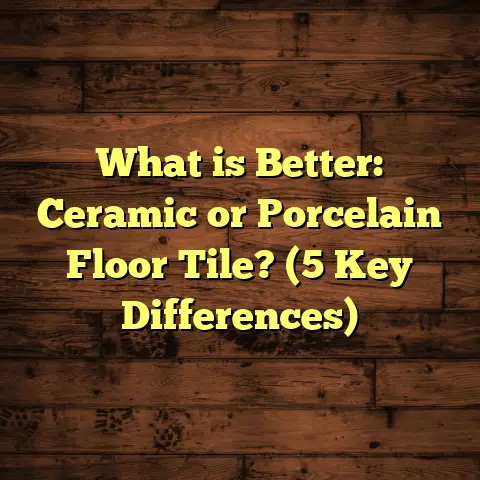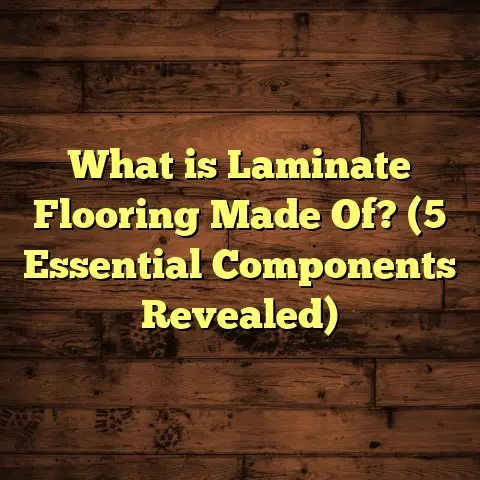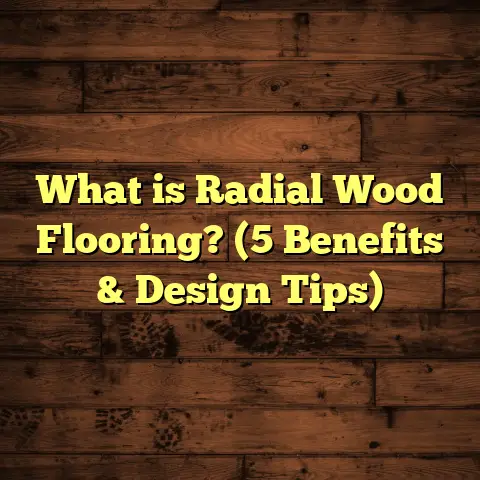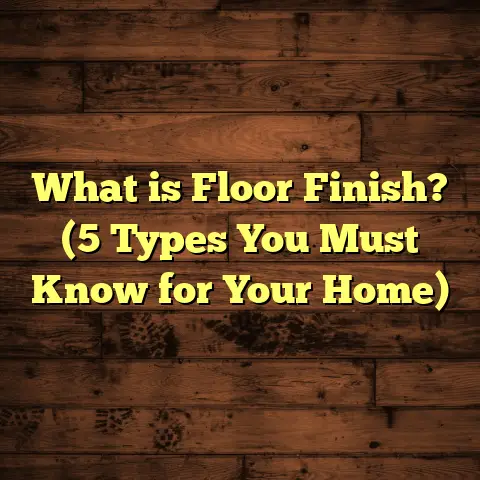What is More Durable: Laminate or Vinyl Flooring? (5 Key Factors)
What if you were standing in a room with two flooring options laid out before you—laminate and vinyl—and you had to pick which one would last longer? Maybe you’re imagining a busy household with kids and pets, or a space that sees a lot of foot traffic. Which floor would hold up better? I’ve faced this exact question with many clients and friends over the years, and I’ve also tested these materials in real-world settings. Today, I want to share everything I’ve learned about the durability of laminate versus vinyl flooring, focusing on five key factors that matter most.
What is Durability in Flooring?
Durability is a word that gets thrown around a lot when people talk about flooring. But what does it really mean? When I talk about durability with homeowners or business owners, I emphasize that it’s not just about how hard or tough a material feels. It’s about how well the floor handles everyday life—from the little things like scratches from pet claws and shoes to bigger challenges like spills, drops, and even sunlight exposure.
I think of durability as a combination of several elements:
- Scratch resistance: How well does the floor resist marks from shoes, furniture, pets’ nails, or dropped objects?
- Moisture resistance: Can the floor handle spills, humidity, or even minor flooding without warping or swelling?
- Impact resistance: When something heavy falls on the floor, does it dent or chip?
- UV resistance: How well does the floor maintain its color and texture when exposed to sunlight over time?
- Longevity: How long will the floor maintain its appearance and functionality before it needs to be replaced?
Durability also includes how easy the floor is to maintain because some materials might be tough but require intensive care to keep looking good.
When choosing between laminate and vinyl flooring, these factors play a key role. Both materials are popular alternatives to hardwood or tile because they offer affordability and style, but their durability profiles differ substantially.
1. Scratch and Impact Resistance
Laminate Flooring
Laminate flooring is constructed from pressed fiberboard layers topped with a photographic layer that mimics wood or stone patterns. This photographic layer is protected by a clear wear layer made of melamine resin—a hard plastic that offers scratch resistance.
From my experience working with laminate flooring for over a decade, its scratch resistance is one of its strong suits. I remember one project where a client had two large dogs that were pretty rough on the floors. After six months of running, playing, and scratching, the laminate floors showed only minor superficial scratches—nothing deep enough to require refinishing or replacement.
But laminate isn’t invincible. While it resists surface scratches well, it can chip or dent if something heavy drops on it or if furniture is dragged roughly across the surface. This damage tends to show up more along the edges of planks where lamination can lift or chip.
I’ve done some digging into industry data on scratch resistance:
- The melamine wear layer on laminate scores around 7 on the Mohs hardness scale (where diamond is 10).
- This means laminate can resist scratches from most common household objects like keys, pet claws, and shoes.
However, laminate floors with thinner wear layers (under 12 mil) are more prone to visible scratches over time.
Vinyl Flooring
Vinyl flooring—especially luxury vinyl tile (LVT) and luxury vinyl plank (LVP)—has become very popular because of its durability and waterproof nature. Vinyl consists of multiple layers of PVC topped with a clear wear layer designed to protect against scratches and dents.
I installed vinyl flooring in a busy retail store where carts were constantly rolling over floors and customers had heavy foot traffic daily. After two years of constant use, the vinyl showed fewer scratches than laminate floors I had installed in similar environments.
The secret lies in the wear layer thickness:
- Vinyl wear layers range from 6 mil (for residential) up to 20 mil (commercial grade).
- Floors with wear layers above 12 mil resist scratches better than most laminates.
- Some commercial vinyl floors have protective coatings that prevent scuffs and gouges altogether.
Tip: If you want vinyl for scratch resistance, always choose LVT/LVP with at least a 12 mil wear layer. Anything less will perform more like sheet vinyl and be less durable.
2. Moisture and Water Resistance
Laminate Flooring
If there’s one major drawback I’ve observed with laminate flooring over the years, it’s moisture sensitivity. Standard laminate has a core made from high-density fiberboard (HDF), which absorbs water like a sponge when exposed for too long. This absorption causes swelling and warping that’s often irreversible.
I remember early in my flooring career installing laminate in a basement apartment. The homeowner didn’t realize the moisture level was high beneath the floor. Within months, we started seeing bubbling and lifting around seams. This experience taught me to always test moisture levels before recommending laminate for any below-grade installation.
Standard laminate has a water absorption rate around 7%, which isn’t ideal for damp environments like bathrooms or basements.
That said, technology has improved dramatically. Some manufacturers now produce water-resistant laminates with specially treated cores and sealed edges that reduce water damage risk. I installed one such product in a kitchen renovation last year where spills were frequent. So far (after 18 months), no signs of swelling or damage have appeared.
Vinyl Flooring
Vinyl flooring shines when it comes to moisture resistance. Being made mostly of plastic, vinyl doesn’t absorb water at all.
In my projects involving bathrooms, laundry rooms, and basements, vinyl has consistently held up without any warping or damage—even when water has been spilled or leaked underneath.
Its water absorption rate is practically zero. This makes vinyl an excellent choice for areas prone to spills or high humidity.
Pro tip: If your home sees lots of moisture—think kids’ mudroom entries or basements—you’ll want to lean towards vinyl over laminate for peace of mind.
3. Ease of Maintenance and Longevity
Laminate Flooring
People often ask me whether laminate floors are hard to keep clean. My answer: not really—if you follow some simple rules.
Laminate floors clean up nicely with regular sweeping and dry mopping to remove dust and grit that can scratch surfaces. However, avoid soaking them with water because excess moisture can seep into joints and cause damage.
I recommend damp mopping with microfiber pads and using cleaners specifically designed for laminate flooring.
In terms of lifespan, quality laminate floors typically last between 10-25 years. That’s a broad range because so many factors influence durability:
- Traffic levels
- Maintenance
- Installation quality
- Product quality
One family I worked with had kids running around for over 15 years on their laminate floors without major issues except some minor scratches near entryways.
Vinyl Flooring
Vinyl is even easier to maintain because water won’t harm it. You can mop with mild detergents freely without worrying about damage.
Vinyl’s longevity depends largely on wear layer thickness:
- Residential vinyl lasts 10-15 years on average.
- Commercial-grade vinyl can last 20+ years under heavy use.
In retail spaces where I installed commercial vinyl flooring over ten years ago, the floors still look great after routine cleaning and occasional buffing.
Vinyl doesn’t require refinishing like hardwood, so maintenance costs tend to be lower over time.
4. Appearance Over Time: Fading and Wear
Laminate Flooring
I’ve noticed laminate floors maintain their look well if kept out of direct sunlight. The photographic layer that gives them wood-like beauty is protected by a melamine topcoat but isn’t UV-proof.
In rooms with large windows facing west or south where afternoon sun streams in strongly, I’ve seen fading occur after several years. One client’s living room had noticeable color changes near windows after five years.
This fading happens because UV rays break down pigments in the photographic layer.
Vinyl Flooring
Vinyl flooring generally resists UV fading better than laminate due to its plastic composition.
In stores where I installed vinyl floors next to large glass windows, colors remained vibrant after years of sun exposure.
Some manufacturers add UV inhibitors into their wear layers specifically to combat fading.
A quick note: Even though vinyl resists fading better than laminate, placing either floor under thick rugs or away from sun exposure prolongs their appearance further.
5. Cost vs. Value: What You Get for Your Money
Let me lay out some numbers from my recent projects combined with national averages:
| Flooring Type | Average Cost per sq.ft | Expected Lifespan | Maintenance Cost | Durability Rating (out of 10) |
|---|---|---|---|---|
| Laminate | $2 – $6 | 10 – 25 years | Low | 7 |
| Vinyl | $2 – $7 | 10 – 20 years | Very Low | 8 |
Both types offer affordable options compared to hardwood or tile but vinyl tends to provide better all-around durability at similar costs—especially in wet or high-use areas.
A few things I tell clients about cost/value:
- Installation costs can vary widely depending on subfloor condition.
- Vinyl sometimes costs more upfront for thicker wear layers.
- Laminate may require more repairs if damaged by moisture.
- Vinyl’s ease of maintenance saves money long-term.
My Takeaway: When to Choose Laminate vs. Vinyl Flooring
If you ask me which floor is more durable overall, my answer depends on your situation:
- If your space stays dry and you want an authentic wood look at an affordable price, laminate works great.
- If moisture is present or expected (kitchen, bathroom, basement), vinyl is safer.
- For scratch resistance with pets/kids, choose vinyl with a thick wear layer.
- For ease of maintenance under heavy foot traffic or commercial use, vinyl wins.
- If budget is tight but you want longevity without fuss, consider mid-range vinyl products.
Helpful Tips from My Experience
Here are some practical tips from my years installing both flooring types:
- Always check wear layer thickness on vinyl; it’s a game changer.
- Test moisture levels before installing laminate.
- Use felt pads under furniture legs on laminate floors.
- Clean spills immediately on laminate to prevent swelling.
- Choose reputable brands with good warranties.
- Get samples and try them out at home before buying.
- Hire experienced installers; poor installation reduces durability.
- Use rugs or mats at entryways to reduce dirt impact.
- Avoid dragging heavy furniture across floors.
- Consider underlayment options that improve comfort and reduce noise.
A Case Study From My Work
Let me tell you about a family who wanted both durability and style for their home renovation. They chose laminate planks for their living room but installed luxury vinyl planks in their kitchen right next door for water resistance.
After two years:
- The kitchen’s vinyl looked flawless despite spills and constant use.
- The living room’s laminate had minor edge chips near doorways from moving furniture.
- Both floors cleaned easily but the family preferred vinyl’s softer feel underfoot.
- Color fading was noticeable only on laminate near large windows.
- Maintenance time was lower for vinyl since spills wiped up without worry.
This real-life example shows why knowing your space’s needs helps make the best choice.
Additional Insights: Environmental Impact & Sustainability
Another angle many people ask me about is environmental impact:
- Laminate uses wood byproducts but often contains adhesives with VOCs (volatile organic compounds).
- Vinyl is PVC-based plastic which raises recycling concerns but newer products are increasingly recyclable.
- Both industries are working on greener production methods.
From my viewpoint, balancing durability with sustainability means choosing longer-lasting floors that don’t need replacement frequently—thus reducing waste overall.
Final Thoughts — Which Floor Will Outlast?
If you want my honest opinion based on years of experience:
Vinyl flooring tends to be more durable overall, especially in moisture-prone or high traffic areas.
Laminate holds its own in dry settings where aesthetic wood look matters most but requires more care around water and sunlight exposure.
Ultimately durability isn’t just about the material—it’s about how you use it, maintain it, and install it correctly.
If you want help weighing your options based on your home’s specific needs or want recommendations tailored to your lifestyle and budget, just reach out!
The choice between laminate and vinyl flooring isn’t just about style—it’s about finding a floor that stands up to your life day after day without losing its good looks or integrity. And now you’re armed with all the info you need to make that call confidently.





